Marcello Mastroianni (1924-1996) was Italy's favourite leading man of the second half of the 20th century. In his long and prolific career, he almost singlehandedly defined the contemporary type of Latin lover, then proceeded to redefine it a dozen times and finally parodied it and played it against type.

American postcard by Fotofolio, no. Z860. Photo: Milton H. Greene. Caption: Marcello Mastroianni, Rome, 1963.

Italian postcard by Turismofoto, no. 76.
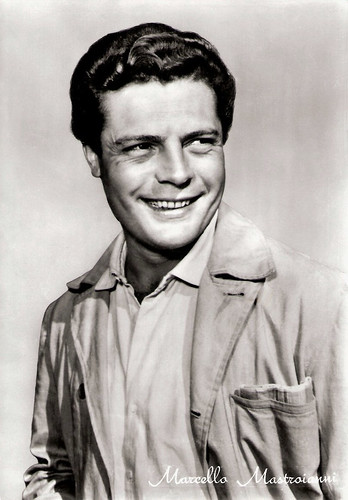
Italian postcard by Rotal Foto, Milano (Milan), no. 250.
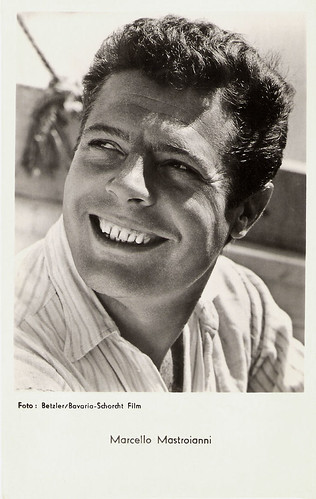
Franco-German postcard by Ufa AG, Berlin / Editions P.I., Paris. Photo: Betzler / Bavaria / Schorcht Film.
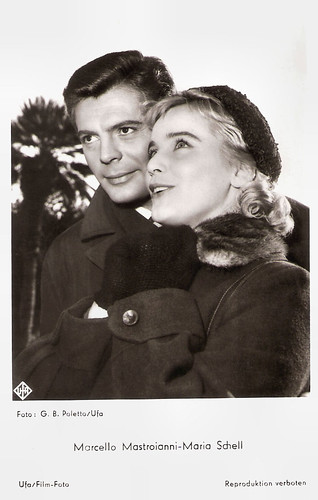
German postcard by Ufa, Berlin-Tempelhof, no. FK 3486. Photo: G.B. Poletto. Publicity still for Le notti bianche / White Nights (Luchino Visconti, 1957) with Maria Schell.

Romanian postcard by Casa Filmului Acin, no. 159. Anouk Aimée and Marcello Mastroianni in La dolce vita / The Sweet Life (Federico Fellini, 1960).

Chinese postcard. Marcello Mastroianni and Jeanne Moreau in La Notte / The Night (Michelangelo Antonioni, 1961).

French postcard by Edition La Malibran, Paris, no. MC 38, 1990. Photo: Claude Schwartz. Publicity still for Otto e Mezzo / 8½ (Federico Fellini, 1963) with Claudia Cardinale.
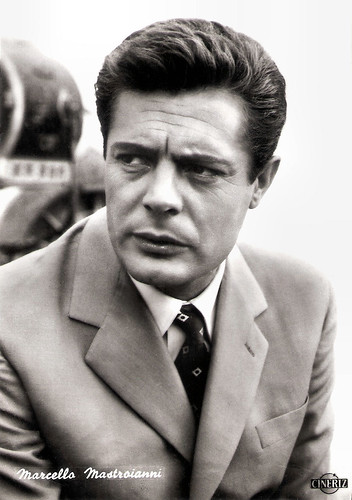
Italian postcard by Bromofoto, no. 1445. Photo: Cineriz.
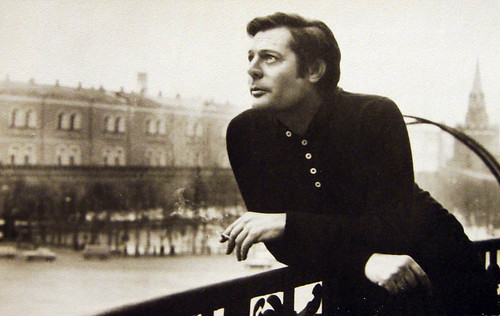
Russian postcard from 1987. Collection: Pierre sur le Ciel.
Marcello Vincenzo Domenico Mastroianni was born in Fontana Liri, a small village in the Apennines, in 1924. He was the son of Ida (née Irolle) and Ottone Mastroianni, who ran a carpentry shop. Marcello grew up in Turin and Rome. He appeared as an uncredited extra in Marionette (Carmine Gallone, 1939) and later appeared as an extra in Una storia d'amore / Love Story (Mario Camerini, 1942) and I bambini ci guardano / The Children Are Watching Us (Vittorio De Sica, 1944). He worked in his father's carpentry shop, but during World War II he was put to work by the Germans drawing maps. From 1943 to 1944 he was imprisoned in a forced labour camp, but he escaped and hid in Venice.
In 1944, Mastroianni started working as a cashier for the film company Eagle Lion (Rank) in Rome. He began taking acting lessons and acted with the University of Rome dramatic group. In the university's production of Angelica (1948), he appeared with Giulietta Masina. His first real film credit was in I Miserabili / Les misérables (Riccardo Freda, 1948) with Gino Cervi. That year Mastroianni joined Luchino Visconti's repertory company, which was bringing to Italy a new kind of theatre and novel ideas of staging. The young actor played Mitch in 'A Streetcar Named Desire', Happy in 'Death of a Salesman', Stanley Kowalski in Visconti's second staging of Streetcar, and roles in Anton Chekhov's 'Three Sisters' and 'Uncle Vanya'.
He also acted in radio plays and he had his first substantial film role in the comedy Una domenica d'agosto / Sunday in August (Luciano Emmer, 1949). In 1955 Mastroianni co-starred with Vittorio De Sica and Sophia Loren - an actress with whom he would frequently be paired in the years to come - in the Screwball comedy Peccato che Sia una Canaglia / Too Bad She's Bad (Alessandro Blasetti, 1955) and later worked with De Sica again on the comedy Padri e Figli / Like Father, Like Son (Mario Monicelli, 1957).
His roles gradually increased in importance, but for the most part, both the casts and crews of his projects were undistinguished, and he remained unknown outside of Italy. Mastroianni permanently sealed his stardom in Italy, playing a timid clerk whose love is not reciprocated by Maria Schell, in Le notti bianche/White Nights (Luchino Visconti, 1957). He soon became a major international star appearing in films like I soliti ignoti/Big Deal on Madonna Street (Mario Monicelli, 1958) with Vittorio Gassman. In this classic crime caper, he displayed a light touch of comedy, playing the exasperated member of an inept group of burglars.
In 1960 he played his most famous role as a disillusioned and world-weary tabloid columnist who spends his days and nights exploring Rome's high society in Federico Fellini's La dolce vita / The Sweet Life (1960) with Anita Ekberg. La dolce vita changed the look and direction of the Italian cinema. Hal Erickson at AllMovie: "Throughout his adventures, Marcello's dreams, fantasies, and nightmares are mirrored by the hedonism around him. With a shrug, he concludes that, while his lifestyle is shallow and ultimately pointless, there's nothing he can do to change it so he might as well enjoy it. Fellini's hallucinatory, circus-like depictions of modern life first earned the adjective 'Felliniesque' in this celebrated movie, which also traded on the idea of Rome as a hotbed of sex and decadence. A huge worldwide success, La Dolce Vita won several awards, including a New York Film Critics Circle award for Best Foreign Film and the Palme d'Or at the Cannes Film Festival."

Italian postcard by Bromofoto, Milano, no. 460. Photo: Atlantis Film. Marcello Mastroianni in Febbre di vivere / Eager to Live (Claudio Gora, 1953).

Spanish postcard by F.A.G. Marcello Mastroianni and Marina Vlady in Giorni d'amore / Days of Love (Giuseppe De Santis, 1954).

Italian postcard by Turismofoto, no. 94.

Big East-German card by VEB Progress Film-Vertrieb, Berlin, no. 68/72. Photo: Steffen.
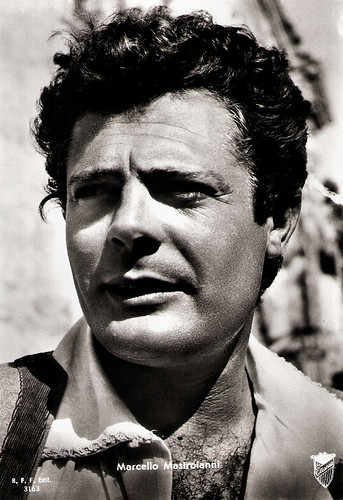
Italian postcard by B.F.F. Edit., no. 3163. Photo: Titanus. Publicity still for La Bella Mugnaia / The Miller's Beautiful Wife (Mario Camerini, 1955).

Dutch postcard by Uitg. Takken, no. AX 3203. Photo: Standaardfilms. Publicity still for Padri e figli... / Fathers and Sons (Mario Monicelli, 1957).

German postcard by Kolibri-Verlag, Minden / Westf., no. 2361. Photo: Bavaria / Schorcht / Vogelmann. Publicity still for Mädchen und Männer / La ragazza della salina / Sand, Love and Salt (1957).

Italian postcard. Marcello Mastroianni in I soliti ignoti/ Big Deal on Madonna Street (Mario Monicelli, 1958). The old man in the back is Carlo Pisacane.

Vintage photo. Marcello Mastroianni and Rosanna Schiaffino in Un ettaro di cielo / Piece of the Sky (Aglauco Casadio, 1958).

Italian postcard by Nuova Arti Grafiche Ricordi S.R.L. / Cinisello Balsamo, no. 2996, 1998. Photo: publicity still for Il bell' Antonio/Bell' Antonio (Mauro Bolognini, 1960).

Small Czechoslovakian card by Pressfoto, Praha (Prague), no. S 83/7, 1965. Retail price: 0,50 Kcs. Anita Ekberg and Marcello Mastroianni in La dolce vita (Federico Fellini, 1960).

Small Czech collector card by Pressfoto, Praha (Prague), 1965, no. S 83/6. Stefania Sandrelli and Marcello Mastroianni in Divorzio all'italiana / Divorce, Italian Style (Pietro Germi, 1961).
During the 1960s Marcello Mastroianni played in many great films and regularly worked with top Italian and French filmmakers. He appeared as the title character in Il bell'Antonio / Bell' Antonio (Mauro Bolognini, 1960) and starred in Michelangelo Antonioni’s masterpiece La notte / The Night (1961), where again his distanced, expressionless demeanour fit perfectly into the film's air of alienation and remote emotionality. He appeared in interesting films like L'assassino / The Assassin (Elio Petri, 1961), La Vie Privée / A Very Private Affair (Louis Malle, 1962) with Brigitte Bardot, and Cronaca familiare / Family Diary (Valerio Zurlini, 1962) with Jacques Perrin.
Mastroianni followed La dolce vita with another signature role for Fellini, that of Fellini’s alter-ego, a film director who, amidst self-doubt and troubled love affairs, finds himself in a creative block while making a film in Otto e Mezzo / 8½ (Federico Fellini, 1962). The film won two Academy Awards. Mastroianni won the British BAFTA award twice for his roles in the black comedy Divorzio all'Italiana / Divorce, Italian Style (Pietro Germi, 1963) and the deliciously funny three-part sex farce Ieri, oggi, domani / Yesterday, Today, and Tomorrow (Vittorio De Sica, 1963) costarring with Sophia Loren. He and Loren starred together again in the equally amusing sex comedy Matrimonio all'italiana/Marriage Italian Style (Vittorio De Sica, 1964).
According to Elaine Mancini on Film Reference “Mastroianni's masculinity blends perfectly with Loren's exuberant earthy personality” in both these films. While he was to become known for playing Latin lover roles (which he spoofed in Casanova 70 (Mario Monicelli, 1965), his characters often were far more complexly drawn. They were not one-dimensional pretty boys; rather, beneath their handsome exteriors they were lazy, world-weary, and doubt-ridden. Other films were La decima vittima/The Tenth Victim (Elio Petri, 1965) with Ursula Andress and the Albert Camus adaptation Lo Straniero/The Stranger (Luchino Visconti, 1967) with Anna Karina.
Mastroianni won the Best Actor award at the Cannes Film Festival for Dramma della gelosia - tutti i particolari in cronaca/Drama of Jealousy (Ettore Scola, 1970). In 1987 he would win the award again for Oci ciornie/Dark Eyes (Nikita Mikhalkov, 1987). Mastroianni, Dean Stockwell and Jack Lemmon are the only actors to have won the award twice. During the 1970s Mastroianni continued to work in interesting films by prolific directors like Leo the Last (John Boorman, 1970), Permette? Rocco Papaleo/My Name Is Rocco Papaleo (Ettore Scola, 1971) with Lauren Hutton, Che?/What? (Roman Polanski, 1972) with Sydne Rome and La donna della domenica/The Sunday Woman (Luigi Comencini, 1975) with Jacqueline Bisset.
He often worked with controversial director Marco Ferreri at Liza (Marco Ferreri, 1972) with Catherine Deneuve, La Grande Bouffe/Blow Out (Marco Ferreri, 1973), Touche pas à la femme blanche/ Don't Touch the White Woman! (Marco Ferreri, 1974), and Ciao maschio/Bye Bye Monkey (Marco Ferreri, 1978) with Gérard Depardieu.Other interesting films are Così come sei/Stay as You Are (Alberto Lattuada, 1978) with Nastassja Kinski, L'ingorgo - Una storia impossibile/Traffic Jam (Luigi Comencini, 1979) with Annie Girardot, and La terrazza/The Terrace (Ettore Scola, 1980) with Vittorio Gassman. He played against his Latin lover image in Scola’s Una giornata particolare/A Special Day (Ettore Scola, 1977), in which Mastroianni's homosexual and Sophia Loren's oppressed housewife come together on the day in 1938 when Adolph Hitler was cheered on the streets of Rome during his visit to Benito Mussolini. His seemingly detached air was perfectly suited to satire as well, as he demonstrated in films as diverse as the historical drama Allonsanfàn (Paolo and Vittorio Taviani, 1974), and La città delle donne / City of Women (Federico Fellini, 1980).

Small Czechoslovakian card by Presseojo, Praha (Prague), no. 83/9, 1965. Retail price: 0,50 Kcs. Marcello Mastroianni in 8½ (Federico Fellini, 1963).

Small Czechoslovakian card by Pressfoto, Praha (Prague), no. S 83/8, 1965. Retail price: 0,50 Kcs. Marcello Mastroianni in I compagni/The Organiser (Mario Monicelli, 1963).
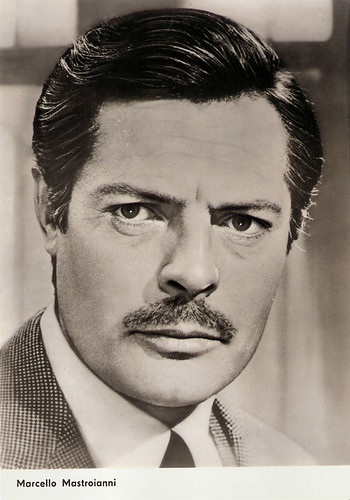
East-German postcard by VEB Progress Film-Vertrieb, Berlin, no. 2634. Photo: publicity still for Matrimonio all'italiana / Marriage Italian Style (Vittorio De Sica, 1964).
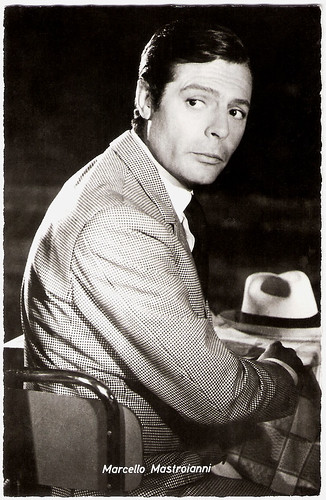
German postcard by Friedrich W. Sander Verlag, Minden. Photo: Inter Film. Still for Casanova 70 (Mario Monicelli, 1965).

Romanian postcard by Casa Filmului Acin. Marcello Mastroianni in Lo Straniero / The Stranger (Luchino Visconti, 1967).
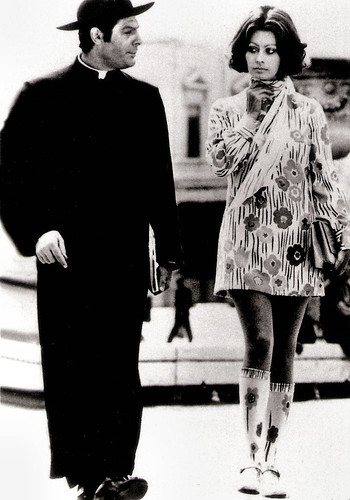
German postcard by pwe Verlag, München (Munich). Photo: publicity still for La moglie del prete / The Priest's Wife (Dino Risi, 1970) with Sophia Loren.
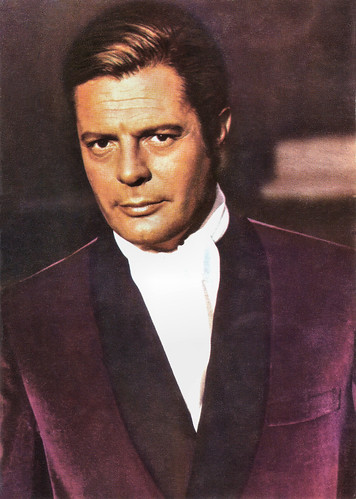
Romanian postcard by Casa Filmului Acin, no. 4881.

Russian postcard by Izdanije Byuro Propogandy Sovietskogo Kinoiskusstva, no. 3624, 1975. This postcard was printed in an edition of 200.000 cards. Retail price: 5 kop.
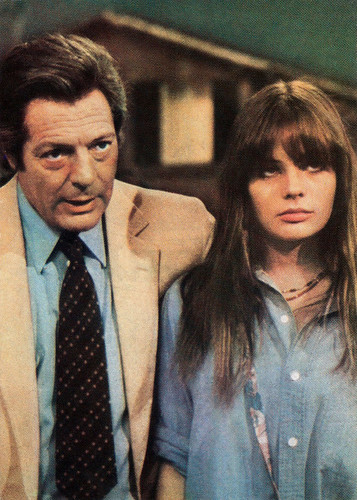
Romanian postcard by Casa Filmului Acin. Photo: publicity still for La terrazza (Ettore Scola, 1980) with Marie Trintignant.

Romanian postcard by Casa Filmului Acin. Photo: publicity still for Enrico IV / Henry IV (Marco Bellocchio, 1984).
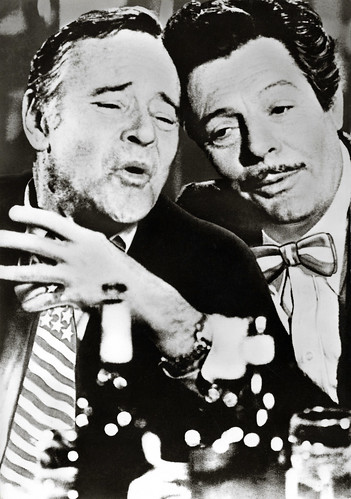
Big East-German card by VEB Progress Film-Verleih, Berlin, no. 1020. Jack Lemmon and Marcello Mastroianni in Maccheroni / Macaroni (Ettore Scola, 1985).

German press photo, no. 5. Photo: Tobis. Publicity still for Ginger e Fred (Federico Fellini, 1986).

French postcard in the Collection Magie Noire by Éditions Hazan, Paris, 1997, no. 6521. Photo: Constant Anée. Marcello Mastroianni and Sophia Loren in Prêt-à-Porter (Robert Altman, 1994).
In the latter stages of his career, Marcello Mastroianni continued to take serious dramatic roles. For instance, he played the senior citizen who simply looks back on his past. In Stanno tutti bene / Everybody's Fine (Giuseppe Tornatore, 1990), he is an elderly man who is absorbed in his memories, and who travels through Italy to call on his five adult children. In Oci ciornie / Dark Eyes (Nikita Mikhalkov, 1987), he gives a tour-de-force performance as a once young and idealistic aspiring architect who married a banker's daughter, fell into a lifestyle of afternoon snoozes and philandering, and proved incapable of holding onto what was important to him.
His on-screen presence has also been directly linked to his earlier screen characterisations. In Prêt-à-Porter / Ready to Wear (Robert Altman, 1994), he was reunited with Sophia Loren, and at one point in the scenario, she recreated her famous steamy striptease sequence from Yesterday, Today, and Tomorrow. Loren was as beguiling as she had been 30 years earlier but Mastroianni was no longer the attentive young lover, so Sophia's seductive moves only put him to sleep. Mastroianni's appearance in two of Fellini's final features is especially sentimental. Ginger e Fred / Ginger and Fred (Federico Fellini, 1996) is sweetly nostalgic for its union of Mastroianni and Giulietta Masina, two of the maestro's then-ageing but still vibrant stars of the past.
In Intervista (Federico Fellini, 1987), he appears as himself with Anita Ekberg, with whom he had starred decades before in La dolce vita. Mastroianni's entrance is especially magical; the sequence in which he and Ekberg (who, he remarks, he has not seen since making La dolce vita) observe their younger selves in some famous clips from that film is wonderfully nostalgic. with a Lifetime Achievement Award at the European Film Awards. He kept appearing in critically acclaimed films like To meteoro vima tou pelargou / The Suspended Step of the Stork (Theodoros Angelopoulos, 1991), in which he was quietly poignant as an obscure man who may have once been an important Greek politician who had disappeared years earlier.
Other films were Al di là delle nuvole / Beyond the Clouds (Michelangelo Antonioni, 1995) and Trois vies et une seule mort / Three Lives and Only One Death (Raúl Ruiz, 1996) with Anna Galiena. His final film was Viagem ao Princípio do Mundo / Voyage to the Beginning of the World (Manoel de Oliveira, 1997). Marcello Mastroianni was married to Italian actress Flora Carabella (1926-1999) from 1948 until his death. They had one child together, Barbara. Mastroianni also had a daughter, actress Chiara Mastroianni, with French film star Catherine Deneuve, his longtime lover during the 1970s.
Both Flora and Catherine were at his bedside in Paris when he died of pancreatic cancer at the age of 72, as was his partner at the time, author and filmmaker Anna Maria Tatò. According to Christopher Wiegand and Paul Duncan in their book Federico Fellini, when Mastroianni died in 1996, the Fontana di Trevi (Trevi Fountain), which is so famously associated with him due to his role in Fellini's La dolce vita, was symbolically turned off and draped in black as a tribute. His brother Ruggero Mastroianni (1929-1996) was a highly regarded film editor who edited several of Marcello's films directed by Federico Fellini and appeared alongside Marcello in Scipione detto anche l'Africano / Scipio the African (Luigi Magni, 1971), a comedic take on the once popular Peplum, the Sword and Sandal film genre. Marcello Mastroianni has held starring roles in about 120 films throughout his long career.
Trailer for Domenica d'agosto (1950). Source: Ugo Tramontano (YouTube).
The classic Trevi Fountain scene in La dolce vita/The Sweet Life (1960) with Anita Ekberg. Source: רונן אברהם (YouTube).
Trailer for 8 1/2 (1961). Source: BFI (YouTube).
Trailer for La Notte (1961). Source: Hadalat (YouTube).
Trailer for Ieri, oggi, domain / Yesterday, Today, and Tomorrow (1963). Source: Jeffrey M. Anderson (YouTube).
Trailer for La Grande Bouffe/Blow Out (1973). Source: Arrow Video (YouTube).
Trailer for Una giornata particulate / A Special Day (1977). Source: Argent Films (YouTube).
Trailer for La città delle done / City of Women (1980). Source: Das Film Feuilleton (YouTube).
Trailer for Ginger e Fred / Ginger and Fred (1986). Source: Movieclips Trailer Vault (YouTube).

Spanish poster postcard. Marcello Mastroianni in the Franco-Portuguese film Voyage to the Beginning of the World / Viagem ao Princípio do Mundo / Voyage au début du Monde (Manoel de Oliveira, 1997). It was Mastroianni's final film.
Sources: Elaine Mancini (Film Reference; updated by Rob Edelman), Hal Erickson (AllMovie - Page now defunct), Jason Ankeny (AllMovie - Page now defunct), Wikipedia and IMDb.

American postcard by Fotofolio, no. Z860. Photo: Milton H. Greene. Caption: Marcello Mastroianni, Rome, 1963.

Italian postcard by Turismofoto, no. 76.

Italian postcard by Rotal Foto, Milano (Milan), no. 250.

Franco-German postcard by Ufa AG, Berlin / Editions P.I., Paris. Photo: Betzler / Bavaria / Schorcht Film.

German postcard by Ufa, Berlin-Tempelhof, no. FK 3486. Photo: G.B. Poletto. Publicity still for Le notti bianche / White Nights (Luchino Visconti, 1957) with Maria Schell.

Romanian postcard by Casa Filmului Acin, no. 159. Anouk Aimée and Marcello Mastroianni in La dolce vita / The Sweet Life (Federico Fellini, 1960).

Chinese postcard. Marcello Mastroianni and Jeanne Moreau in La Notte / The Night (Michelangelo Antonioni, 1961).

French postcard by Edition La Malibran, Paris, no. MC 38, 1990. Photo: Claude Schwartz. Publicity still for Otto e Mezzo / 8½ (Federico Fellini, 1963) with Claudia Cardinale.

Italian postcard by Bromofoto, no. 1445. Photo: Cineriz.

Russian postcard from 1987. Collection: Pierre sur le Ciel.
Forced-labour camp
Marcello Vincenzo Domenico Mastroianni was born in Fontana Liri, a small village in the Apennines, in 1924. He was the son of Ida (née Irolle) and Ottone Mastroianni, who ran a carpentry shop. Marcello grew up in Turin and Rome. He appeared as an uncredited extra in Marionette (Carmine Gallone, 1939) and later appeared as an extra in Una storia d'amore / Love Story (Mario Camerini, 1942) and I bambini ci guardano / The Children Are Watching Us (Vittorio De Sica, 1944). He worked in his father's carpentry shop, but during World War II he was put to work by the Germans drawing maps. From 1943 to 1944 he was imprisoned in a forced labour camp, but he escaped and hid in Venice.
In 1944, Mastroianni started working as a cashier for the film company Eagle Lion (Rank) in Rome. He began taking acting lessons and acted with the University of Rome dramatic group. In the university's production of Angelica (1948), he appeared with Giulietta Masina. His first real film credit was in I Miserabili / Les misérables (Riccardo Freda, 1948) with Gino Cervi. That year Mastroianni joined Luchino Visconti's repertory company, which was bringing to Italy a new kind of theatre and novel ideas of staging. The young actor played Mitch in 'A Streetcar Named Desire', Happy in 'Death of a Salesman', Stanley Kowalski in Visconti's second staging of Streetcar, and roles in Anton Chekhov's 'Three Sisters' and 'Uncle Vanya'.
He also acted in radio plays and he had his first substantial film role in the comedy Una domenica d'agosto / Sunday in August (Luciano Emmer, 1949). In 1955 Mastroianni co-starred with Vittorio De Sica and Sophia Loren - an actress with whom he would frequently be paired in the years to come - in the Screwball comedy Peccato che Sia una Canaglia / Too Bad She's Bad (Alessandro Blasetti, 1955) and later worked with De Sica again on the comedy Padri e Figli / Like Father, Like Son (Mario Monicelli, 1957).
His roles gradually increased in importance, but for the most part, both the casts and crews of his projects were undistinguished, and he remained unknown outside of Italy. Mastroianni permanently sealed his stardom in Italy, playing a timid clerk whose love is not reciprocated by Maria Schell, in Le notti bianche/White Nights (Luchino Visconti, 1957). He soon became a major international star appearing in films like I soliti ignoti/Big Deal on Madonna Street (Mario Monicelli, 1958) with Vittorio Gassman. In this classic crime caper, he displayed a light touch of comedy, playing the exasperated member of an inept group of burglars.
In 1960 he played his most famous role as a disillusioned and world-weary tabloid columnist who spends his days and nights exploring Rome's high society in Federico Fellini's La dolce vita / The Sweet Life (1960) with Anita Ekberg. La dolce vita changed the look and direction of the Italian cinema. Hal Erickson at AllMovie: "Throughout his adventures, Marcello's dreams, fantasies, and nightmares are mirrored by the hedonism around him. With a shrug, he concludes that, while his lifestyle is shallow and ultimately pointless, there's nothing he can do to change it so he might as well enjoy it. Fellini's hallucinatory, circus-like depictions of modern life first earned the adjective 'Felliniesque' in this celebrated movie, which also traded on the idea of Rome as a hotbed of sex and decadence. A huge worldwide success, La Dolce Vita won several awards, including a New York Film Critics Circle award for Best Foreign Film and the Palme d'Or at the Cannes Film Festival."

Italian postcard by Bromofoto, Milano, no. 460. Photo: Atlantis Film. Marcello Mastroianni in Febbre di vivere / Eager to Live (Claudio Gora, 1953).

Spanish postcard by F.A.G. Marcello Mastroianni and Marina Vlady in Giorni d'amore / Days of Love (Giuseppe De Santis, 1954).

Italian postcard by Turismofoto, no. 94.

Big East-German card by VEB Progress Film-Vertrieb, Berlin, no. 68/72. Photo: Steffen.

Italian postcard by B.F.F. Edit., no. 3163. Photo: Titanus. Publicity still for La Bella Mugnaia / The Miller's Beautiful Wife (Mario Camerini, 1955).

Dutch postcard by Uitg. Takken, no. AX 3203. Photo: Standaardfilms. Publicity still for Padri e figli... / Fathers and Sons (Mario Monicelli, 1957).

German postcard by Kolibri-Verlag, Minden / Westf., no. 2361. Photo: Bavaria / Schorcht / Vogelmann. Publicity still for Mädchen und Männer / La ragazza della salina / Sand, Love and Salt (1957).

Italian postcard. Marcello Mastroianni in I soliti ignoti/ Big Deal on Madonna Street (Mario Monicelli, 1958). The old man in the back is Carlo Pisacane.

Vintage photo. Marcello Mastroianni and Rosanna Schiaffino in Un ettaro di cielo / Piece of the Sky (Aglauco Casadio, 1958).

Italian postcard by Nuova Arti Grafiche Ricordi S.R.L. / Cinisello Balsamo, no. 2996, 1998. Photo: publicity still for Il bell' Antonio/Bell' Antonio (Mauro Bolognini, 1960).

Small Czechoslovakian card by Pressfoto, Praha (Prague), no. S 83/7, 1965. Retail price: 0,50 Kcs. Anita Ekberg and Marcello Mastroianni in La dolce vita (Federico Fellini, 1960).

Small Czech collector card by Pressfoto, Praha (Prague), 1965, no. S 83/6. Stefania Sandrelli and Marcello Mastroianni in Divorzio all'italiana / Divorce, Italian Style (Pietro Germi, 1961).
Not one-dimensional pretty boys
During the 1960s Marcello Mastroianni played in many great films and regularly worked with top Italian and French filmmakers. He appeared as the title character in Il bell'Antonio / Bell' Antonio (Mauro Bolognini, 1960) and starred in Michelangelo Antonioni’s masterpiece La notte / The Night (1961), where again his distanced, expressionless demeanour fit perfectly into the film's air of alienation and remote emotionality. He appeared in interesting films like L'assassino / The Assassin (Elio Petri, 1961), La Vie Privée / A Very Private Affair (Louis Malle, 1962) with Brigitte Bardot, and Cronaca familiare / Family Diary (Valerio Zurlini, 1962) with Jacques Perrin.
Mastroianni followed La dolce vita with another signature role for Fellini, that of Fellini’s alter-ego, a film director who, amidst self-doubt and troubled love affairs, finds himself in a creative block while making a film in Otto e Mezzo / 8½ (Federico Fellini, 1962). The film won two Academy Awards. Mastroianni won the British BAFTA award twice for his roles in the black comedy Divorzio all'Italiana / Divorce, Italian Style (Pietro Germi, 1963) and the deliciously funny three-part sex farce Ieri, oggi, domani / Yesterday, Today, and Tomorrow (Vittorio De Sica, 1963) costarring with Sophia Loren. He and Loren starred together again in the equally amusing sex comedy Matrimonio all'italiana/Marriage Italian Style (Vittorio De Sica, 1964).
According to Elaine Mancini on Film Reference “Mastroianni's masculinity blends perfectly with Loren's exuberant earthy personality” in both these films. While he was to become known for playing Latin lover roles (which he spoofed in Casanova 70 (Mario Monicelli, 1965), his characters often were far more complexly drawn. They were not one-dimensional pretty boys; rather, beneath their handsome exteriors they were lazy, world-weary, and doubt-ridden. Other films were La decima vittima/The Tenth Victim (Elio Petri, 1965) with Ursula Andress and the Albert Camus adaptation Lo Straniero/The Stranger (Luchino Visconti, 1967) with Anna Karina.
Mastroianni won the Best Actor award at the Cannes Film Festival for Dramma della gelosia - tutti i particolari in cronaca/Drama of Jealousy (Ettore Scola, 1970). In 1987 he would win the award again for Oci ciornie/Dark Eyes (Nikita Mikhalkov, 1987). Mastroianni, Dean Stockwell and Jack Lemmon are the only actors to have won the award twice. During the 1970s Mastroianni continued to work in interesting films by prolific directors like Leo the Last (John Boorman, 1970), Permette? Rocco Papaleo/My Name Is Rocco Papaleo (Ettore Scola, 1971) with Lauren Hutton, Che?/What? (Roman Polanski, 1972) with Sydne Rome and La donna della domenica/The Sunday Woman (Luigi Comencini, 1975) with Jacqueline Bisset.
He often worked with controversial director Marco Ferreri at Liza (Marco Ferreri, 1972) with Catherine Deneuve, La Grande Bouffe/Blow Out (Marco Ferreri, 1973), Touche pas à la femme blanche/ Don't Touch the White Woman! (Marco Ferreri, 1974), and Ciao maschio/Bye Bye Monkey (Marco Ferreri, 1978) with Gérard Depardieu.Other interesting films are Così come sei/Stay as You Are (Alberto Lattuada, 1978) with Nastassja Kinski, L'ingorgo - Una storia impossibile/Traffic Jam (Luigi Comencini, 1979) with Annie Girardot, and La terrazza/The Terrace (Ettore Scola, 1980) with Vittorio Gassman. He played against his Latin lover image in Scola’s Una giornata particolare/A Special Day (Ettore Scola, 1977), in which Mastroianni's homosexual and Sophia Loren's oppressed housewife come together on the day in 1938 when Adolph Hitler was cheered on the streets of Rome during his visit to Benito Mussolini. His seemingly detached air was perfectly suited to satire as well, as he demonstrated in films as diverse as the historical drama Allonsanfàn (Paolo and Vittorio Taviani, 1974), and La città delle donne / City of Women (Federico Fellini, 1980).

Small Czechoslovakian card by Presseojo, Praha (Prague), no. 83/9, 1965. Retail price: 0,50 Kcs. Marcello Mastroianni in 8½ (Federico Fellini, 1963).

Small Czechoslovakian card by Pressfoto, Praha (Prague), no. S 83/8, 1965. Retail price: 0,50 Kcs. Marcello Mastroianni in I compagni/The Organiser (Mario Monicelli, 1963).

East-German postcard by VEB Progress Film-Vertrieb, Berlin, no. 2634. Photo: publicity still for Matrimonio all'italiana / Marriage Italian Style (Vittorio De Sica, 1964).

German postcard by Friedrich W. Sander Verlag, Minden. Photo: Inter Film. Still for Casanova 70 (Mario Monicelli, 1965).

Romanian postcard by Casa Filmului Acin. Marcello Mastroianni in Lo Straniero / The Stranger (Luchino Visconti, 1967).

German postcard by pwe Verlag, München (Munich). Photo: publicity still for La moglie del prete / The Priest's Wife (Dino Risi, 1970) with Sophia Loren.

Romanian postcard by Casa Filmului Acin, no. 4881.

Russian postcard by Izdanije Byuro Propogandy Sovietskogo Kinoiskusstva, no. 3624, 1975. This postcard was printed in an edition of 200.000 cards. Retail price: 5 kop.

Romanian postcard by Casa Filmului Acin. Photo: publicity still for La terrazza (Ettore Scola, 1980) with Marie Trintignant.

Romanian postcard by Casa Filmului Acin. Photo: publicity still for Enrico IV / Henry IV (Marco Bellocchio, 1984).

Big East-German card by VEB Progress Film-Verleih, Berlin, no. 1020. Jack Lemmon and Marcello Mastroianni in Maccheroni / Macaroni (Ettore Scola, 1985).

German press photo, no. 5. Photo: Tobis. Publicity still for Ginger e Fred (Federico Fellini, 1986).

French postcard in the Collection Magie Noire by Éditions Hazan, Paris, 1997, no. 6521. Photo: Constant Anée. Marcello Mastroianni and Sophia Loren in Prêt-à-Porter (Robert Altman, 1994).
Wonderfully nostalgic
In the latter stages of his career, Marcello Mastroianni continued to take serious dramatic roles. For instance, he played the senior citizen who simply looks back on his past. In Stanno tutti bene / Everybody's Fine (Giuseppe Tornatore, 1990), he is an elderly man who is absorbed in his memories, and who travels through Italy to call on his five adult children. In Oci ciornie / Dark Eyes (Nikita Mikhalkov, 1987), he gives a tour-de-force performance as a once young and idealistic aspiring architect who married a banker's daughter, fell into a lifestyle of afternoon snoozes and philandering, and proved incapable of holding onto what was important to him.
His on-screen presence has also been directly linked to his earlier screen characterisations. In Prêt-à-Porter / Ready to Wear (Robert Altman, 1994), he was reunited with Sophia Loren, and at one point in the scenario, she recreated her famous steamy striptease sequence from Yesterday, Today, and Tomorrow. Loren was as beguiling as she had been 30 years earlier but Mastroianni was no longer the attentive young lover, so Sophia's seductive moves only put him to sleep. Mastroianni's appearance in two of Fellini's final features is especially sentimental. Ginger e Fred / Ginger and Fred (Federico Fellini, 1996) is sweetly nostalgic for its union of Mastroianni and Giulietta Masina, two of the maestro's then-ageing but still vibrant stars of the past.
In Intervista (Federico Fellini, 1987), he appears as himself with Anita Ekberg, with whom he had starred decades before in La dolce vita. Mastroianni's entrance is especially magical; the sequence in which he and Ekberg (who, he remarks, he has not seen since making La dolce vita) observe their younger selves in some famous clips from that film is wonderfully nostalgic. with a Lifetime Achievement Award at the European Film Awards. He kept appearing in critically acclaimed films like To meteoro vima tou pelargou / The Suspended Step of the Stork (Theodoros Angelopoulos, 1991), in which he was quietly poignant as an obscure man who may have once been an important Greek politician who had disappeared years earlier.
Other films were Al di là delle nuvole / Beyond the Clouds (Michelangelo Antonioni, 1995) and Trois vies et une seule mort / Three Lives and Only One Death (Raúl Ruiz, 1996) with Anna Galiena. His final film was Viagem ao Princípio do Mundo / Voyage to the Beginning of the World (Manoel de Oliveira, 1997). Marcello Mastroianni was married to Italian actress Flora Carabella (1926-1999) from 1948 until his death. They had one child together, Barbara. Mastroianni also had a daughter, actress Chiara Mastroianni, with French film star Catherine Deneuve, his longtime lover during the 1970s.
Both Flora and Catherine were at his bedside in Paris when he died of pancreatic cancer at the age of 72, as was his partner at the time, author and filmmaker Anna Maria Tatò. According to Christopher Wiegand and Paul Duncan in their book Federico Fellini, when Mastroianni died in 1996, the Fontana di Trevi (Trevi Fountain), which is so famously associated with him due to his role in Fellini's La dolce vita, was symbolically turned off and draped in black as a tribute. His brother Ruggero Mastroianni (1929-1996) was a highly regarded film editor who edited several of Marcello's films directed by Federico Fellini and appeared alongside Marcello in Scipione detto anche l'Africano / Scipio the African (Luigi Magni, 1971), a comedic take on the once popular Peplum, the Sword and Sandal film genre. Marcello Mastroianni has held starring roles in about 120 films throughout his long career.
Trailer for Domenica d'agosto (1950). Source: Ugo Tramontano (YouTube).
The classic Trevi Fountain scene in La dolce vita/The Sweet Life (1960) with Anita Ekberg. Source: רונן אברהם (YouTube).
Trailer for 8 1/2 (1961). Source: BFI (YouTube).
Trailer for La Notte (1961). Source: Hadalat (YouTube).
Trailer for Ieri, oggi, domain / Yesterday, Today, and Tomorrow (1963). Source: Jeffrey M. Anderson (YouTube).
Trailer for La Grande Bouffe/Blow Out (1973). Source: Arrow Video (YouTube).
Trailer for Una giornata particulate / A Special Day (1977). Source: Argent Films (YouTube).
Trailer for La città delle done / City of Women (1980). Source: Das Film Feuilleton (YouTube).
Trailer for Ginger e Fred / Ginger and Fred (1986). Source: Movieclips Trailer Vault (YouTube).

Spanish poster postcard. Marcello Mastroianni in the Franco-Portuguese film Voyage to the Beginning of the World / Viagem ao Princípio do Mundo / Voyage au début du Monde (Manoel de Oliveira, 1997). It was Mastroianni's final film.
Sources: Elaine Mancini (Film Reference; updated by Rob Edelman), Hal Erickson (AllMovie - Page now defunct), Jason Ankeny (AllMovie - Page now defunct), Wikipedia and IMDb.
2 comments:
I enjoyed this post very much. Great pictures.
great pictures
Marcello Mastroianni’s easy charm was an ideal vehicle for portraying decadence. His nonchalant air was redolent with womanizing and sex. However this decadence was aloof. It rarely expressed itself in unabashed glee. A more likely expression was an amused shrug and resigned surrender to the demands of hedonism. He lived this charming persona, redefined it time and again and completed the continuum by parodying it.
http://modernartists.blogspot.in/2012/03/marcello-mastroianni-seductive-look-at.html
Post a Comment